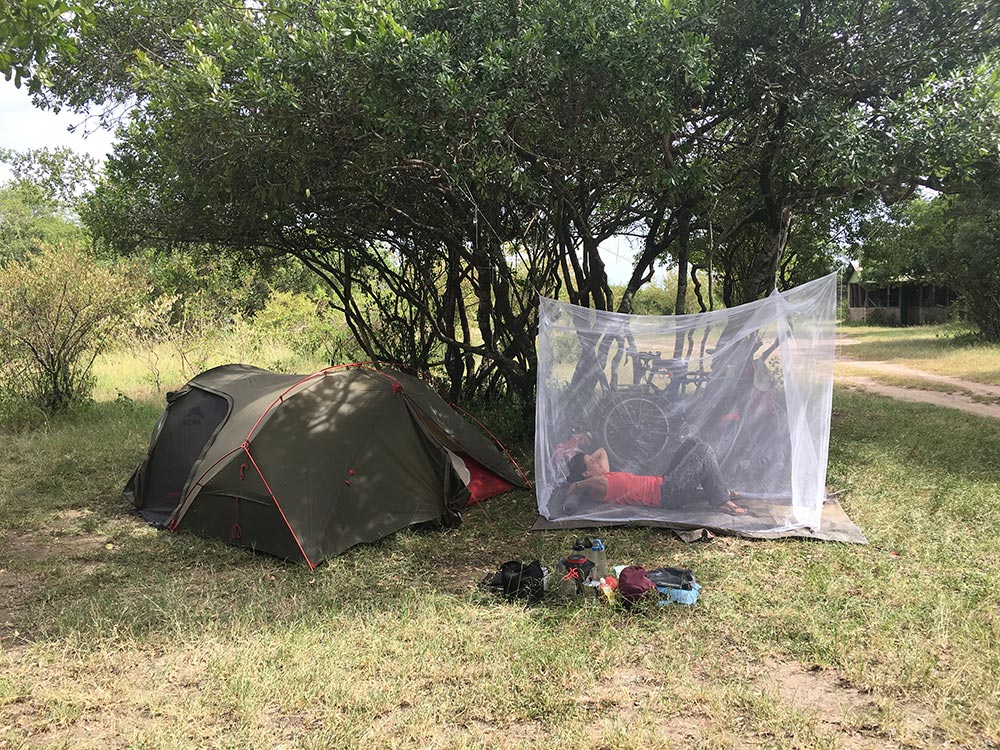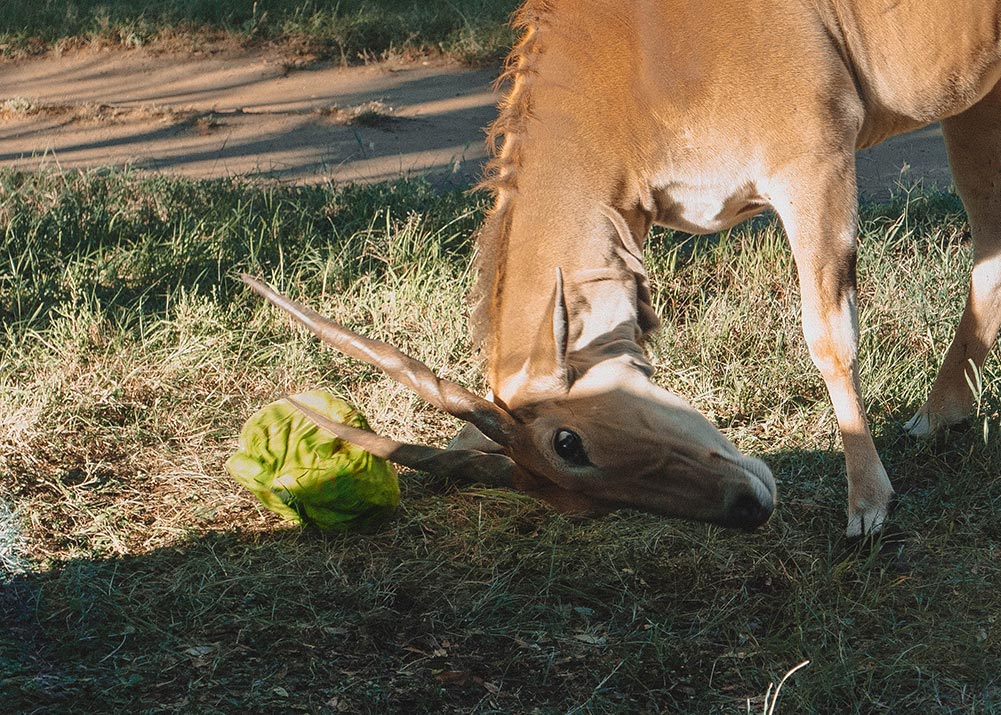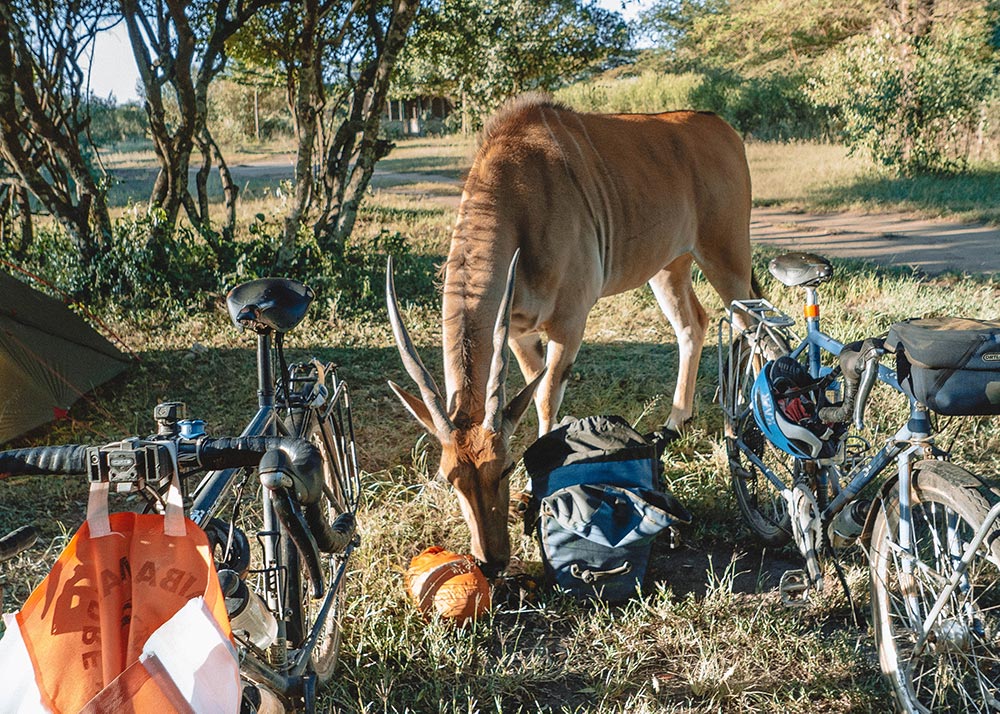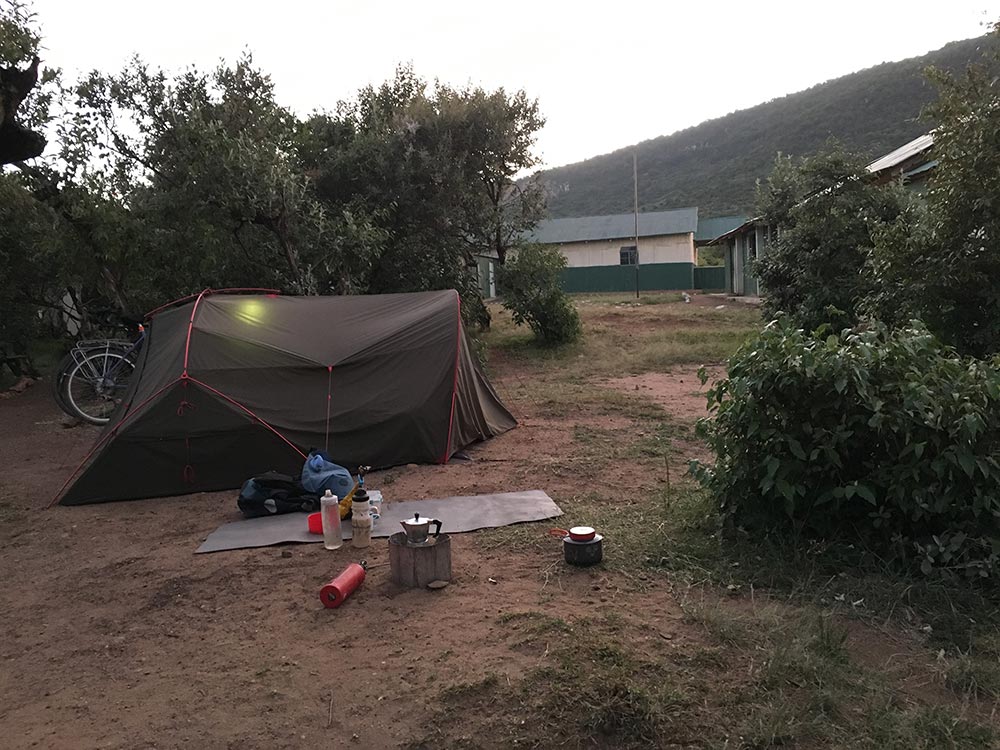07/02/19-13/02/19
Country: Kenya
Distance: 238 km / 148 mi
Elevation: 2,362 m / 7,749 ft
Wildlife spotted on bike: hyena, zebra, baboon, wildebeest, warthog, gazelle, impala, giraffe, elephant (at night), vulture.
On safari: lion and cubs, hyena, elephant, buffalo, impala, zebra, giraffe, baboon, gazelle, jackal, wildebeest, hare, warthog, hippo, duck (lion was playing with it; it survived).
Forget the title for a moment, I’ll get to that. First, did you watch the video above? That’s how we started our week this week. I’m not sure they’ll ever be a better start to a week, than joining in with morning assembly at Maiella Polytechnic: the school we ended last week’s blog post at. The energy the kids had was unreal — infectious, even. Alex, the textiles and hairdressing teacher, called it African energy. We certainly felt it cycling out of Maiella. Our cheeks hurt from smiling so much. Our camp there will definitely stay with us for a longtime.
After leaving Maeilla we made a pitstop in Narok, to stock-up on supplies, before heading towards Maasai Mara National Reserve. On route we saw zebra on the B3, which is like saying you saw zebra on the South Circular in London or the A174 in Middlesbrough. As soon as we stopped to have a good look, they stopped eating and started watching us watching them. Then they ran off. They’re quite nervous creatures. I guess they’re gonna be when there are so many big cats looking to chew on their leg.
Zebra are everywhere.
Avocado sandwiches have become our new favourite lunch option. Giant avocados are only £0.30 and because they’re so creamy, you can get away with no butter.
After a day’s riding off-road in Kenya.
From the B3 highway, we said farewell to tarmac and went off road for the next 100 km. This was when we entered the Maasai area, passing through many a Maasai village. Maasai are arguably Africa’s most well-known tribe, due to them living in and around major wildlife parks, as well as their distinct customs and colourful dress. Maasai live in northern, central and southern Kenya, and northern Tanzania. Actually Kenya’s Maasai Mara National Reserve merges with Tanzania’s Serengeti National Park, and Maasai pass through freely. They predominately speak Maa, but have learned the official languages of Kenya and Tanzania, English and Swahili. Despite the Kenyan and Tanzanian governments best efforts to extinguish the Maasai’s traditional semi-nomadic lifestyle, they still continue their age-old customs today.
50 km in we stopped for the night in Lemek. Since the government office was closed, we pulled up outside the local bar and asked if there was a safe place to camp in the village (imagine doing that at home…). A guy jumped straight on the phone and called the head police officer, who dashed from his house to meet us. He said we could camp behind his place no problem. It was also where the Maasai Mara National Reserve security were based, too. We definitely felt secure when we saw their machine guns. When we were tucked up in our tent (at 7.30pm because it was pitch black), the police officer popped over to say goodnight and make sure we were okay. Kenyans are awesome.
From Lemek we cycled to Talek, which is another Maasai village and literally the gateway to the national reserve. This was the section Mark, the wildlife guy from last week, had warned us to be careful riding. Not wanting to be eaten by stray park animals (there are no fences), we contacted the lodge we were heading to, to arrange a pick-up. They got back to us and said it would be safe to cycle the whole way. We also asked some villagers and the friendly police officer in Lemek, and they too said it would be safe to cycle. So we did. And to be honest, it felt alright. There were a few moments when we stopped to assess what animal we could see on the horizon, but it was always cattle or zebra or wildebeest. We managed to cycle all the way to the front door of Maasai Mara National Reserve without losing a limb. Winning. Even better, we’d booked our safari for the following morning and were sat supping a cold beer, toasting to our wild ride.
Dan, ever the handyman, made a fantastic bug-free outdoor seating area with our mozzy net. Maasai Mara, or simply Mara as locals affectionately call it, is apparently rife for malaria, so we were extra careful.
The safari was indescribable. We set off at 5.45am and within the first hour had a close encounter with hyena — actually we spotted one in the village before we entered the park, when it was still dark — elephants and lions. We felt like we were slap-bang in the middle of an epic Davey A BBC wildlife show. It far exceeded any expectations we had. The density of animals on the plains was astounding. We must have passed tens of thousands of animals. It’s like nothing we’ve ever seen before, except maybe that scene in The Lion King when all the animals celebrate Simba’s birth by singing Circle of Life. Zebra, baboons, gazelle, wildebeest, buffalo, giraffe. Just masses of food for predators. Yet the big cats we did see were just lazing about amongst them all, seemingly not hungry at all. We did see a pride of lions tucking into a zebra, however — they just ripped it apart with ease. Oh that beautiful circle of life. And we were lucky enough to see a lioness with her three two-month-old cubs. There was a moment of panic from Mamma when one of her cubs went astray. It was heart-wrenching watching her search for the little one, while it was heading in the complete opposite direction. Nature can be so tense.
Our half day safari was supposed to last from 6am until 9am/10am, but we think James, our guide and driver, took a shine to us, as we didn’t get back until 11am. At 8.30am James said the animal drive was over and that he could take us to a Maasai village to watch the tribe dance and experience their culture. That isn’t really our thing. People aren’t animals to be paraded around and perform on cue, plus we’d already met so many lovely Maasai when we’d camped and cycled through the villages en-route to Telek. So we declined and said let’s just head back. But we didn’t head back; we drove around for another 2.5 hours! He took us to all the hotspots he knows for elephants, hyenas and leopards (we didn’t see them though). Then we headed back. Totally gobsmacked. If you missed the slideshow we posted on Instagram, I’ve embedded all the posts at the bottom of this blog post.
James had eyes like a hawk. It was rather impressive.
There were heaps of safari cars parked around the lions, but all other animals we saw, it was just us.
We were knackered by the end of the safari and spent the afternoon napping in the sun.
So, I bet you’re wondering what it cost us, since I said last week we had worked out a way, with help from Mark, to do it cheaply? What do you reckon, £350 each? £500 maybe? £800? What would you say if I told you Dan and I went on a safari in Kenya’s most famous reserve all in for £108 each? Yup. Didn’t think you’d believe me. Here’s how we did it.
The trick is to make your own way to the reserve, as that’s a fair chunk of money if you booked from Nairobi, for example. Being on bikes, transport cost us nothing. We have seen tourists driving hired 4WDs, which I appreciate would be a big expense, but it would give you so much more freedom during your trip — and some even have pop-up tents on the top. Which brings me to my next tip: bring your own accommodation. Safari lodges charge a small fortune to stay in a luxury camp, which is essentially a tent full of bohemian-styled pillows and throws. The place we stayed, Aruba Mara Camp, charge around £50 per night for their accommodation and that’s cheap. Yet it only cost 800 Kenya Shilling (£6) per person per night to pitch our tent in their campsite, and we had access to a dry seating area, 24 hour hot showers, somewhere to wash the pots and of course, their bar/restaurant. Aruba Mara Camp is metres from Maasai Mara’s Talek Gate, too, which means you’re pretty much in the park — we spotted warthogs from their bar. They also offer half-day safaris for €30 per person, either morning or evening. You can do both sessions by doubling the price, but we didn’t feel the need to, as we’d seen so much in the morning. Then there’s the park entrance fee, which is an unavoidable $80 per person per 24 hours. Now in our research, Maasai Mara came out as one of the more expensive parks to visit in East Africa, but you’d be hard-pressed to find a cheaper guided tour, so it actually worked out cheaper overall. Tours were the big expense when visiting, say, Kidepo Valley National Park in Uganda.
Add it all up and convert it and you get the grand total of £216 for two people, which included three nights’ accommodation, a half-day safari and park entrance. Bargain. I will say that this is the frugal way to do it. There’s no plush glamping tent, breakfast with a Maasai tribe or candle lit dinner with a view of the park. But we didn’t go for that; we went for the wildlife and we got to see plenty. Oh, we also tipped James $10 as he was ace and tipping is kind of expected. I’ve stuck a few extra tips at the bottom of this post, just in case you fancy doing what we’ve done. Might save you a few bob.
As we’re approaching one year on the road, some of our kit is starting to feel the brunt of daily use. The internal seams in Dan’s Therm-a-Rest mattress have come away, meaning it blows up like a balloon rather than a bed. We’ve contacted Therm-a-Rest and are in the process of getting another one sent out, since it’s covered under a Limited Lifetime Warranty.
After a rest day in Talek, we were ready to pack-up and move on. While we were getting ready to leave, it appeared that our safari was not over. Like I mentioned before, there are no fences around the reserve, so wild animals are free to roam wherever they choose. And one huge impala decided to roam right into our camp. He was fine at first, just grazing on the bushes, but then he took an interest in our bags, more specifically our food bag. When Dan attempted to retrieve it, the cheeky toe-rag went to charge him. I’ll give you three guess where they get their name from… In the end camp security came to our aid, but by that time he had annihilated our Vango dry bag and everything in it. Super noodles. Biscuits. Crackers. Avocados. All gone. It was a simple dinner that night.
The unofficial safari did not end there. 20 km after Talek, when we figured we were well clear of the park, we only went and cycled past a hyena didn’t we. Dan noticed some vultures circling above something and we thought it was amazing, ‘awesome, we’ve not seen vultures yet!’. But on closer inspection, he noticed they were circling a hyena eating. And it had noticed us. I’m not gonna lie, we were terrified. It’s a bloody big cat and it was less than 100 m away. We pedalled as fast as the gravelly incline would allow, craning our necks to make sure we weren’t being followed. In hindsight, he was probably making sure we weren’t going to steal his food, but nevertheless, it’s not an encounter we wish to repeat.
And still the unofficial safari continued… That evening we camped in a local Maasai village, which has a problem with elephants sneaking in during the night and eating their vegetables. We were camping right next to the school’s veg patch and a 4am heard an intruder come for a feed. Elephants are super smart, and I swear it tried to outsmart the security guard, who’s hired to shoo them off. As we waited and listened, the elephant seemed to stop eating when he heard the security guard leave his hut and wander around. When the elephant thought the coast was clear, he resumed eating. He was eventually found of course, as they make such a racket when they’re tearing and eating food. There was a slight panic that we may be trampled when the security guard finally scared him off, but the elephant thankfully escaped in the opposite direction.
It’s funny, we started the week having camped at a school and ended the week camping at another, yet the two experiences couldn’t have been more different – and I’m not just talking about the big-eared visitor.
At Maeilla Polytechnic I think we were the first white people some of the kids had ever met. A lot of them asked to touch our skin or hair. They wanted to know what life was like in England and how it compared to Kenya. Their English wasn’t so great either, with more advanced kids or teachers acting as translators. The whole experience felt heartwarming and authentic; they genuinely seemed happy and excited to meet us. Fast-forward to Kileleoni Primary School and it was very different indeed.
Camping at Kileleoni Primary School. The elephant was no more the 40 m left of the tent.
Kileleoni village is in ‘partnership’ with a handful of very high-end hotels in the area, whereby flashy holidaymakers pay them a visit for a fee. It’s a tour essentially. This is the type of village we chose to avoid on our safari. Pastor Cyrus, the guy running the show – sorry, the church – used to work at the fancy Fairmont Hotel before deciding to help the village. And don’t get my wrong, he has seemingly done wonders. There’s a school, toilet block, water supply. But something just didn’t sit right with me.
After giving us his pitch and school tour, Pastor Cyrus ushered us to the playground to watch the children play games. He then introduced us to a young Maasai boy, who had changed into traditional Maasai dress. He was there to give us a tour of his village. We politely declined. The young boy went on to say how great it would be to find a sponsor, so he could go to college. In the same breath he also confirmed with Pastor Cyrus that they were expecting six to nine tour groups on Friday and that some were bringing gifts for the children. Then he peppered the rest of our conversation with things, I assume, he thought we’d like to hear: he has killed a lion, his Dad has killed six, his dad is the chief of all Maasai, he will be the next chief of all Maasai, thanks to Pastor Cyrus he found God, and he’s thankful God created this world (Maasai have their own religion FYI). Of course it may have all been true. But I wan’t so sure. Dan said I was being cynical. And maybe I was. But I couldn’t help feel awkward and uneasy about the whole (staged?) experience. Dan pointed out that ultimately the kids are getting an education and the village has things like running water, so even if it is a big show/con/lie, they’re doing good, which is the most important thing. I guess.
When we said goodbye the following day we left a small donation with the teachers, guilt-ridden that we couldn’t leave more, but even more guilty that they think this is what Westerners want to see (is it?). Then we started to make our way northwest towards Uganda.
INSTA-ANIMALS
Tips for Aruba Mara Camp
**WARNING** If you do cycle to Talek, do so at your own risk. The threat of wildlife is real. While plenty of people told us it was safe to cycle to Talek, we cycled past a hyena and an elephant came into camp when we stayed in a local village. Always get up-to-date advice from locals.
Book your safari as soon as you arrive. Everyone told us the morning slot is better and we can vouch for that after such a successful morning safari ourselves.
Take extra camera batteries on your safari. Dan used two. And make sure your memory card has enough space for plenty of snaps. Dan took thousands.
The guy at reception told us we needed a full safari car in order to go. That wasn’t true. We just booked at the restaurant and we ended up having a car to ourselves.
When paying a big sum in cash, count the money out loud — this is a tip for all over Kenya. There was an awkward moment when Dan was getting his change. We suspect it was likely innocent, but we have read that’s one of the scams here, to say money is missing or shortchange you.
We booked three nights camping, as we thought we’d have to wait for a full safari car, but we could have left after two nights.
If you’re coming from the euro zone, bring euros! Weirdly Aruba Mara Camp charge in euros, only accept cash, and use their own exchange rate. The €60 safari cost us €63 as we paid in dollars ($72).
Cook your own food. Food and drink is expensive at their restaurant. Meals are €10-€15 and beer is €3.50 a pop. There are a few little shops in Talek, where you can stock-up on basics like veg and bread, but we carried most of our food from Narok.
In Talek there’s also a petrol station if you need fuel for your stove or car. And there’s a KCB Bank, which from our previous experiences accepts MasterCard as well as Visa, although we didn’t use that specific ATM.





















